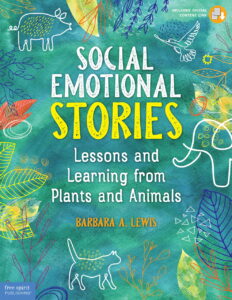 You probably remember the beloved story of the Ugly Duckling. It resonates with anyone who has ever been left out, teased, or lonely—which pretty much includes all of us. We feel empathy for the misjudged duckling. And when that “duck” discovers he’s a beautiful swan, it gives hope to all that when we discover our true identities, we can also become beautiful.
You probably remember the beloved story of the Ugly Duckling. It resonates with anyone who has ever been left out, teased, or lonely—which pretty much includes all of us. We feel empathy for the misjudged duckling. And when that “duck” discovers he’s a beautiful swan, it gives hope to all that when we discover our true identities, we can also become beautiful.
That’s the power of stories. They can make us feel empathy for the characters when we are transported into their worlds. This makes stories a powerful way to help kids develop socially and emotionally as they live, imaginatively and safely, through the experiences of others.
Stories have never been needed more than they are today. Many students are facing mental, emotional, and social challenges that stem from the unexpected pandemic of 2020. The coronavirus has sparked fears of losing a loved one and challenges related to distance learning, putting food on the table, and keeping friendships and connections with others. Stories can help young people connect with one another through understanding and empathy. For example, here are some questions and activities to engage children after you tell or read the story of the Ugly Duckling that help kids develop socially and emotionally now and in the future.
Discussion Questions
- Why do you think the other ducks said that the Ugly Duckling was ugly?
- Why might someone bully another person because of the way they look?
- Can you tell what a person is like by the way they look?
- How do you think the Ugly Duckling felt when other ducks poked fun at him? Have you ever felt that way?
- If you know what it feels like to be excluded or bullied, what might you do if you see someone being excluded from an activity at lunch, on the playground, at parties, in the neighborhood, or within the family? Give examples.
- Could there ever be a time when you should judge the way a person looks? How would it be different from the case of the Ugly Duckling?
Activities Connected to The Ugly Duckling
- Set your kids in groups of two to four. If there are only a few children, they can work together in one group. Ask them to dig deeper into the story. They can discuss what they think are the important messages from The Ugly Duckling. You might have to throw out questions to help them get started, such as, Does this story tell you that creatures and people can only be friends with others who are just like them? Can you find other examples of animals who became friends that are not the same? You can let kids do an internet search for examples or provide some articles with fun examples. Check the articles first to be sure you are comfortable with them. Bored Panda’s “15 Unusual Animal Friendships That Will Melt Your Heart” and Lifehack’s “20 Unusual Animal Friendships That Will Amaze You” are good places to start.
- After your initial discussion, ask kids what they now think is the real message of the story. You can lead them toward these SEL ideas and others you think of:
- When you discover the person you really are and can accept your strengths and weaknesses, you become beautiful—just like the Ugly Duckling. Accepting and liking yourself is a beautiful growing experience.
- Does beauty come from looks or from within? What does inner beauty come from? When you see other people for their inside talents, you can become friends with and better connect with them.
The Social and Emotional Power of Stories
There are many strategies today for teaching SEL. But many of the processes can be more powerful when introduced with a story. Why begin with a story? You could talk to children about how important it is to be kind to others until you’re blue in the face. Emotional and social growth can occur when kids have the experience of feeling empathy and other emotions for the characters in a story such as The Ugly Duckling. This empathy helps them connect with and understand other people.
Nature’s creatures and plants are nonthreatening to kids. A story about an animal or a plant can reveal important lessons without pointing a finger at a child. Children don’t feel in competition with a dog or a tree.
For example, suppose kindness is not at the top of Sasha’s list of positive qualities. Perhaps she has a history of bullying others. Comparing Sasha to another child who shows more kindness would probably result in Sasha developing anger and resentment toward the other child. The lesson of kindness would be lost in Sasha’s emotions of disappointment or outrage.
Instead, you might try telling a story of Trakr, the faithful German shepherd dog who dug through 30 feet of dangerous debris to rescue the last survivor of the World Trade Center attack in 2011. This story emphasizes kindness, courage, and service. It can release feelings of empathy within children, and you can then direct this emotion to the joy children can feel when they help someone.
Stories can be told with a child on your lap, in an open classroom, socially distanced six feet apart, or online in distance learning. You don’t have to bring a live duck and a swan into the classroom for kids to feel empathy from the story. Great stories can cross all cultures and people. As with The Ugly Duckling, stories can help kids discover their own identities, connect, and see worth and beauty in themselves as well as others.
